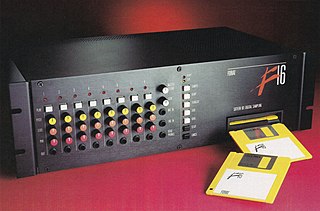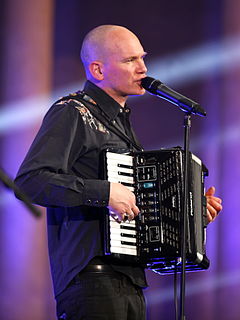
A drum kit — also called a drum set, trap set, or simply drums — is a collection of drums and other percussion instruments, typically cymbals, which are set up on stands to be played by a single player, with drumsticks held in both hands, and the feet operating pedals that control the hi-hat cymbal and the beater for the bass drum. A drum kit consists of a mix of drums and idiophones – most significantly cymbals, but can also include the woodblock and cowbell. In the 2000s, some kits also include electronic instruments. Also, both hybrid and entirely electronic kits are used.

MIDI is a technical standard that describes a communications protocol, digital interface, and electrical connectors that connect a wide variety of electronic musical instruments, computers, and related audio devices for playing, editing and recording music. The specification originates in a paper published by Dave Smith and Chet Wood then of Sequential Circuits at the October 1981 Audio Engineering Society conference in New York City then titled Universal Synthesizer Interface.

A drum machine is an electronic musical instrument that creates percussion sounds, drum beats, and patterns. Drum machines may imitate drum kits or other percussion instruments, or produce unique sounds, such as synthesized electronic tones. Most modern drum machines allow users to program their own rhythms and beats. Drum machines may create sounds using analog synthesis or play prerecorded samples. Some drum machines have buttons or pads that allow the performer to play drum sounds "live", either on top of a programmed drum beat or as a standalone performance. Drum machines have a range of capabilities, which go from playing a short beat pattern in a loop, to being able to program or record complex song arrangements with changes of meter and style.

Digital music technology encompasses digital instruments, computers, electronic effects units, software, or digital audio equipment by a performer, composer, sound engineer, DJ, or record producer to produce, perform or record music. The term refers to electronic devices, instruments, computer hardware, and software used in performance, playback, recording, composition, mixing, analysis, and editing of music.

An analogsynthesizer is a synthesizer that uses analog circuits and analog signals to generate sound electronically.

Modular synthesizers are synthesizers composed of separate modules of different functions. The modules can be connected together with patch cords, a matrix patching system, or switches by the user to create a patch. The output (voltages) from the modules may function as (audio) signals, control voltages, or logic/timing conditions. Typical modules are oscillators, filters (spectrum), amplifiers/gates (amplitude) and Envelope generators.
General MIDI is a standardized specification for electronic musical instruments that respond to MIDI messages. GM was developed by the American MIDI Manufacturers Association (MMA) and the Japan MIDI Standards Committee (JMSC) and first published in 1991. The official specification is available in English from the MMA, bound together with the MIDI 1.0 specification, and in Japanese from the Association of Musical Electronic Industry (AMEI).

Reason is a digital audio workstation for creating and editing music and audio developed by Swedish software company Reason Studios. Reason emulates a rack of hardware synthesizers, samplers, signal processors, sequencers, and mixers, all of which can be freely interconnected in an arbitrary manner. Reason can be used either as a complete virtual music studio or as a set of virtual instruments to be used with other sequencing software in a fashion that mimics live performance.

A MIDI controller is any hardware or software that generates and transmits Musical Instrument Digital Interface (MIDI) data to MIDI-enabled devices, typically to trigger sounds and control parameters of an electronic music performance.

An electronic drum is a modern electronic musical instrument, primarily designed to serve as an alternative to an acoustic drum kit or other percussion instruments. An electronic drum consists of an electronic or digital sound module which produces the synthesized or sampled percussion sounds and one or more electric sensors or sensor-equipped pads to trigger the sounds. Like regular drums, the sensors or pads are struck by drum sticks or by the hands and they are played in a similar manner to an acoustic drum kit.

A sound module is an electronic musical instrument without a human-playable interface such as a piano-style musical keyboard. Sound modules have to be operated using an externally connected device, which is often a MIDI controller, of which the most common type is the musical keyboard. Controllers are devices that provide the human-playable interface and which may or may not produce sounds of its own. Another common way of controlling a sound module is through a sequencer, which is computer hardware or software designed to record and play back control information for sound-generating hardware. Connections between sound modules, controllers, and sequencers are generally made with MIDI, which is a standardized protocol designed for this purpose, which includes special ports (jacks) and cables.

V-Drums is a variety of electronic drums, drum brain modules, and related electronic percussion product manufactured and trademarked by Roland Corporation.

A Zendrum is a hand-crafted MIDI controller that is used as a percussion instrument. The Zendrum was influenced by the "Drumitar," invented by Future Man. There are several Zendrum models that are well-suited for live performances: the Z1, ZX, EXP, ZAP series, LT and the Mallet Pro series and Melodic Finger. The Zendrum ZX and Z1 can be worn like a guitar and consists of a triangular hardwood body with 24 touch-sensitive round MIDI triggers. The EXP has 29 triggers and additional controls. The Zendrum LT can also be worn with a guitar strap, and has 25 MIDI triggers in a symmetrical layout, which provides an ambidextrous playing surface. The ZAP series is designed more for table top use or on a drum stand, with the ZAP1 having 19 triggers, and the ZAP2 having 25 triggers. The triggers are played by tapping or slapping with the fingers or hands. As a controller, the Zendrum does not make any sound by itself. It uses an electronic interface called MIDI to control synthesizers, samplers, drum machines, sound modules, computers or other electronic drum devices that generates the musical and percussive sounds. The Mallet Pro Series is laid out and played like a traditional mallet instrument, like a marimba. The Mallet Pro series has naturally resonating solid walnut bars as triggers.

Simmons is an electronic drum brand, which originally was a pioneering British manufacturer of electronic drums. Founded in 1978 by Dave Simmons, it supplied electronic kits from 1980 to 1994. The drums' distinctive, electronic sound can be found on countless albums from the 1980s. The company closed in 1999 and the Simmons name is currently owned by Guitar Center.

A trigger pad is an electronic sensor on a drum that produces a certain sound assigned from a sound module once the head has been struck. This device allows drummers to play at a constant dynamic regardless of the physical force used.

A guitar synthesizer is any one of a number of musical instrument systems that allow a guitarist to access synthesizer capabilities.

The Forat F16 is the first 16 bit digital sampler optimized for use as a "drum brain" or electronic drum module. It dynamically responds to trigger inputs from MIDI and/or audio signals. With a response time of 0.1 milliseconds, the F16 is the fastest audio triggering digital sampler ever sold. It was manufactured by Forat Music and Electronics, introduced in 1987 at a list price of $5200 and was discontinued in 1994. An optional Remote Control and SCSI capability was available for $1385.

A digital accordion is an electronic musical instrument that uses the control features of a traditional accordion to trigger a digital sound module that produces a synthesized or digitally sampled accordion sounds or, in most instruments, a range of non-accordion sounds, such as orchestral instruments, pipe organ, piano, guitar, and so on. Digital accordions typically encode and transmit key presses and other input as Musical Instrument Digital Interface (MIDI) messages. Most digital accordions need to be plugged into a keyboard amplifier or PA system to hear their sounds. These are not to be confused with "accordion hybrids", which are a standard acoustic accordion with sensors for all the keys and buttons to interface with electronic sounds. This allows the instrument to be played totally acoustically, with no electronic sounds, or, operated to just use the electronics. Combined, there are a myriad amount of sound combinations, and require a trained ear to play properly mixed sounds. These hybrids also require an amplifier and sound module, of which some models have said module mounted inside the acoustic instrument along with the reeds.
The Roland DDR-30 "Alpha Drum" is a digital PCM drum module built by Roland, in early 1985. It was introduced during 1985 Summer NAMM industry trade show in New Orleans.
The Korg DRM-1 Digital Rhythm module built by Korg, in late 1987. It was introduced during 1987 Summer NAMM industry trade show in Chicago.

















